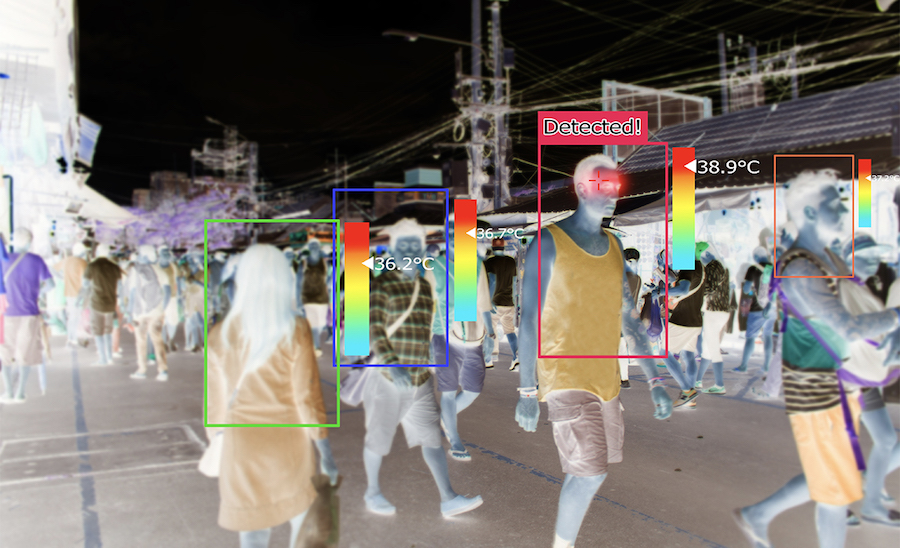A Guide to Implementing Temperature Detection Systems
Battling the Pandemic Requires New Technologies and Thinking

In our continuing blog series on these pages, ASAP Security Services is committed to educating organizations on real technology solutions that can help curb the spread of the COVID-19 pandemic. We have been working closely with the technology suppliers that are working hard to leverage existing technologies and develop solutions that can help organizations, facilities, and services function as normally as possible in these unprecedented times.
We have already discussed the promise – and the challenges – with body temperature detections at scale. As businesses, schools, companies, sports, performing arts, and events all want some ways to operate as before safely, one way of screening for pandemic symptoms is elevated body temperature detection. As we've noted, it is not just a simple matter of installing the right types of cameras in your Houston facilities. The technology needs to be set up correctly, and every organization must have a detailed plan of what they do with people that don't pass the screen.
In this blog, we’re going to cover these implementation issues in greater detail. If you are looking at ways to implement thermal temperature detection systems to help your organization get back to a reasonable level of regular activity with the right precautions, we encourage you to read further in this continuing series on technology solutions to combat the spread of COVID-19.
SEE MORE: How to Evaluate Body Temperature Camera Solutions
The Technology
For thermal temperature detection to work at scale, the technology that enables it is thermal imaging. Thermal imaging is used today in cameras in high-security environments like shipping ports, borders, jails, and some corporate facilities. It has significant advantages over technologies like infrared (IR) for night vision. Unlike IR, heat detection (thermal imaging) can work through smoky and cloudy environments accurately. It's also a more expensive technology, but the cost has been decreasing significantly in recent years.
Detection Accuracy
We have previously discussed both FDA guidelines on the use of the technology for accurate body temperature detection and the sometimes wild claims made by certain vendors. Temperature detection needs to be accurate within 1 or 2 degrees to be an effective screen. A temperature of 100.4 or above is considered a fever. 98.6 is regarded as the standard body temperature in humans, although that varies some across people and can be affected by weather and ambient temperature in the environment. Clearly, anything above a 2-degree variance in accuracy is not workable. Yet many systems that are being marketed today are only accurate to 5-8 degrees, a level of accuracy that is of no use.
Skin temperature can be elevated or lowered based on the ambient temperature. In the heat of the Texas summer, someone entering from extended time outdoors will have raised temperature around their head and face. Conversely, coming out of an air-conditioned car with cold air blowing directly at their face might lower skin temperature significantly as well. The solution? Intelligent camera analytics can quickly focus on the corner of an eye, which can provide an accurate read of actual body temperature. That technology is based on advanced facial recognition capabilities. The cameras that can do it more quickly and best have advanced analytic software that runs in the camera, not in the cloud.
Implementation Considerations
Another area we have discussed before for accurate readings is camera positioning, and the use of a control called a blackbody. The blackbody calibrates the camera, so the detected temperature is compared to the blackbody, which is a constant, known temperature. To implement this effectively, traffic flow must be modified. The challenge to do effective screening at scale is changing flows in a way that doesn't significantly impede normal operations. Think of a sporting event or concert with thousands of people, and the logistics are critical.
One of the options many organizations are considering is maze-like entries that slow down traffic just enough and enable people to pass by a properly positioned camera. If you think of how traffic circles are installed in some neighborhoods to slow down speeds, it's the same concept applied to foot traffic. The other challenge is what to do when someone is flagged for elevated temperature. It is imperative to note that this thermal detection solution is a first-level screen; anyone flagged must be taken aside for another test.
A proper implementation needs to allow for alternate entries for a secondary screening area and have personnel trained to quickly separate those people from others without significantly affecting traffic flow. In some innovative approaches, alternate electronic gates can open for flagged people to go to a specific secondary area, or a light can direct them to one entry if they passed or another if they don’t.
System Integration
As an experienced security integrator, we know that these systems are not islands unto themselves. A thermal temperature detection system should communicate with other security systems, such as keeping counts of flagged people and statistics on accuracy and variance across events, weather conditions, traffic, and other data. They should also integrate with communication systems, such as sending alerts to staff and management on numbers of people flagged to take action if the logistics are breaking down at any point. In a corporate environment with various layers of access control, an identified person may be barred from any entry in some other part of a building or campus.
ASAP Security Services offers integrated technology solutions for comprehensive security and safety. To learn more about thermal temperature detection and other solutions, we invite you to set up a consultation with our team by calling (877) 418-ASAP, filling out our contact form, or starting a live chat with us below. We look forward to working with you!